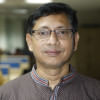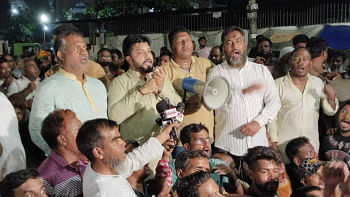Focus on sources of arms, money
The Gulshan café attackers were armed with three AK-22 semi-automatic rifles, among other weapons, prompting investigators to focus on the source of the weapons and the funds.
Investigators say they are also trying to track down the networks of the militant group and the masterminds of the July 1 attack in which 20 hostages, 17 of them foreigners, were killed.
“We are seriously looking into all these aspects,” said an investigator wishing anonymity.
Middle East-based terror group Islamic State took credit for the attack, but the government and the police chief dismissed the claim and said banned outfit JMB was responsible.
In AK-22 rifles, two types of magazines are used. The small one contains 20 bullets and the big one 32 bullets. The rifle can be used both for single fire and rapid fire, said Rab-7 Commanding Officer Lt Col Miftah Uddin Ahmed in Chittagong. Last year, Rab members recovered eight AK-22s from two dens of militant outfit Shaheed Hamja Brigade at Banshkhali in the port city. In the capital's Sadarghat, police recovered two more of them, allegedly left behind by a group of JMB men after a mugging attempt on September 23.
Officials in intelligence and law enforcement agencies believe that the AK-22 rifle has become a favourite with militants in recent months because they are light, easy to carry, make less noise and the ammunition is available in local markets.
“Those can be carried inside clothes and in small backpacks,” the Rab CO told The Daily Star yesterday.
Security personnel said the semi-automatic rifle is loosely based on the AK-47 and was made in Romania. It weighs just three kgs.
Law enforcers said Chittagong is a major route for smuggling in AK-22 rifles. Each of them costs about Tk 4.5 lakh in the black market.
Rab had earlier detained arms dealer Mozaher Hossain Mia of Satkania in Chittagong who was the key supplier of weapons to Shaheed Hamja Brigade, sources said.
Lt Col Miftah Uddin Ahmed said Mozaher used to get the weapons from a man in Pankhoa of Rangamati who got them from the region intersecting India, Myanmar and China.
The smuggler used Mizoram border to bring the arms into the country, he said.
According to the First Information Report (FIR) filed by Sub-Inspector of Gulshan Police Station Ripon Kumar Das, the three AK-22s carry seals mentioning they were made in China, USA and USSR (today's Russia). Seven AK-22 magazines and 79 of its bullets were also found in the Holey Artisan Restaurant and Bakery.
Law enforcers also seized five 9mm pistols, 50 bullets and around 200 bullet shells.
A machete and three knives were also recovered from the spot.
Police prepared four lists of 86 items including five pistols, 11 vehicles, two motorcycles and 11 bicycles, electronics items like mobile phones cameras, passports, currencies and ATM cards of different countries, found at the spot.
The attack on the upscale restaurant is the worst terrorist attack in the country, which came after three years' of targeted killings of writers, bolggers, freethinkers, university professors, foreigners, gay rights activists and members of minority communities, including Hindus, Christians, Buddhists and Shias.
Terror groups Islamic State and Ansar-Al-Islam claimed credit for many of these attacks but the government maintains that IS has no presence in the country.
In the middle of the 11-hour Gulshan café siege, IS claimed it was responsible and published photos of some of the victims within hours of the attack.
But the government claims homegrown banned outfit JMB was behind the attack.
The stand-off finally ended when army commandos stormed the café around 7:40am on July 2, some 11 hours after the siege began, and killed “six suspected terrorists” and rescued 13 hostages.
One of the six was later identified as an employee of the restaurant, but police say he helped the militants and so he is a suspect.
Another injured restaurant staff member, who was detained by police as a suspect, later died in a hospital.
Of the 20 hostages killed, nine are Italian, seven Japanese, one Indian, two Bangladeshis and one Bangladesh-born US citizen.
Two police officers were killed by the attackers when they tried to enter the restaurant soon after the siege began. About 30 policemen were also injured.
Asaduzzaman Miah, commissioner of Dhaka Metropolitan Police, said although the hostage situation was the first of its kind in the country, the Detective Branch and the newly formed Counter Terrorism and Transnational Crime Unit were very capable.
For technical support, they may take assistance from friendly nations like India, Singapore and the US, if needed, he added.
“I will say it's not an issue of law enforcement, it's our national issue. A national consensus is crucial for this and we are working with that aim,” he said.
He said most of the Gulshan attackers were from well-off families and went to private universities. Moreover, one Sholakia attacker, Abir Rahman, was from a similar society.
Police will seek assistance from educational institutions to confront terrorism, he said, adding, “We will of course seek university authorities' assistance to know how the militants are motivated, take training and get patronised. We need to bring such activities under surveillance.”
(Dwaipayan Barua contributed to this report from Chittagong.)

 For all latest news, follow The Daily Star's Google News channel.
For all latest news, follow The Daily Star's Google News channel. 



Comments